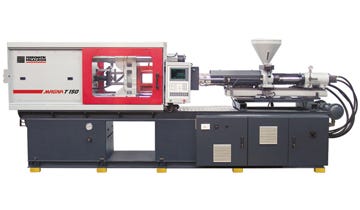Batavia, OH—"We're bringing a new model to market in the depths of a recession we're electing not to participate in," said Milacron VP of Sales Bob Strickley in unveiling the firm's new Magna Toggle line of compact hydraulic presses ranging from 35 to 400 tons' clamp force as PlasticsToday visited Milacron's headquarters last week. Designated the MTH35-MTH400, the line comes in a mono-toggle version from 35-90 tons, and a 10-pin double-toggle configuration from 125-400 tons, the latter with automatic lubrication.
November 17, 2009
Batavia, OH—"We're bringing a new model to market in the depths of a recession we're electing not to participate in," said Milacron VP of Sales Bob Strickley in unveiling the firm's new Magna Toggle line of compact hydraulic presses ranging from 35 to 400 tons' clamp force as PlasticsToday visited Milacron's headquarters last week. Designated the MTH35-MTH400, the line comes in a mono-toggle version from 35-90 tons, and a 10-pin double-toggle configuration from 125-400 tons, the latter with automatic lubrication. The line is the result of a collaboration between Milacron's Ohio manufacturing facility and Milacron's global operations.
|
The firm also offered updates on its BARR VBET screws, a new barrel temperature control system called TCS, and the Powerpak, electric-based injection machines for high-speed, thin-wall packaging applications (see our initial report on the Powerpak introduction at NPE2009). Overall, each of the new technologies supports Milacron's effort to bring "Earth Friendly Technologies" to the market.
Featuring closed loop pressure control, the MTH line is targeted at processors who may be weighing the pros and cons of buying used hydraulic machinery during tough times. "In addition to being a strong, full-hydraulic machine option for processors, the machine is also excellent for someone who doesn’t want to buy all of the problems that come with used machinery and is a good option for those who prefer hydraulics rather than an all-electric” said Strickley. Because of the collaborative development effort, "it's globally designed technology that doesn't need to be proven out," he added. The machines will be delivered from stock, but a host of options are available, including PVC and thermoset kits, core pulls, air eject, and more.
A servo system is also available (MTS) to replace the standard induction motor, and in this setup the electro-hydraulic pump is replaced by an internal gear pump, leading to lower inertia and a highly dynamic speed control system. The servo motor can vary from 0-3000 rpm in both directions, whereas the induction motor is limited to 1750 rpm. Higher rpm delivers more torque for the same power delivered.
The MTH line comes with an electronically controlled variable-volume pump. There are only two manifolds, for the injection unit and the clamp. The machines are said to offer better repeatability, faster response, and fewer hydraulic connections, while approaching the energy efficiency of all-electric machines.
In addition to the MTH and MTS lines, Milacron is also touting the efficacy of its patented BARR VBET (variable barrier energy transfer) screw, which, by means of conductive heating, relies less on shear heat, and offers lower discharge temperatures while maintaining high-quality melt. Melt-temperaure reduction leads to a one-second reduction in cycle time, which, in one example over 6000 hours of operation, equaled 74,805 more parts/yr .
According to Milacron benchmarking against conventional single-flighted screws and barrier screws, the VBET offers a 13-18% higher recovery rate, requires 8-12% less screw motor power, and 9-13% less specific screw energy, all of which equal less total machine energy per part. The total energy reduction is said to be 12% per hour, or 4 kW. Again, at 6000 hours, and a rather low example rate of $.06/kWh for electricity cost, simply using the VBET screw equals $1440 of energy savings per year, which is close to the price difference between the VBET screw and a conventional barrier screw, and does not include the increased profit from lower cycle times (estimated at $22,441, given a 30% profit over the aforementioned 74,805 parts/6000 hours gained in a one-second cycle time reduction). —John Clark
About the Author(s)
You May Also Like



